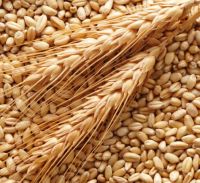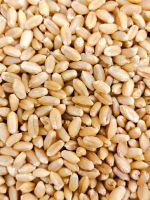Wheat Seeds
- Location: France
- FOB Price: 1380 ~ 1500 / Kilogram ( Negotiable )
- Minimum Order Quantity: 1000 Kilogram
- Supplying Ability: 500000000 Kilogram / Year
- Payment Type: T/T, D/A, Western Union, Money Gram, PayPal
Product Description click to expand contents
- Type: Grass Seeds
- Packaging: Bags
- Grade: A
- Brand Name: Panam
- It is denser and has a higher photosynthetic rate than other leaves, to supply carbohydrate to the developing ear.In temperate countries the flag leaf, along with the second and third highest leaf on the plant,supply the majority of carbohydrate in the grain and their condition is paramount to yield formation.Wheat is unusual among plants in having more stomata on the upper (adaxial) side of the leaf,than on the under (abaxial) side.It has been theorised that this might be an effect of it having been domesticatedand cultivated longer than any other plant.Winter wheat generally produces up to 15 leaves per shoot and spring wheat up to 9and winter crops may have up to 35 tillers (shoots) per plant (depending on cultivar).Wheat roots are among the deepest of arable crops, extending as far down as 2 metres (6 ft 7 in).While the roots of a wheat plant are growing, the plant also accumulates an energy store in its stem,in the form of fructans, which helps the plant to yield under drought and disease pressure,but it has been observed that there is a trade-off between root growth and stem non-structural carbohydrate reserves.Root growth is likely to be prioritised in drought-adapted crops,while stem non-structural carbohydrate is prioritised in varieties developed for countries where disease is a bigger issue.Depending on variety, wheat may be awned or not awned. Producing awns incurs a cost in grain number,but wheat awns photosynthesise more efficiently than their leaves with regards to water usage,so awns are much more frequent in varieties of wheat grown in hot drought-prone countries,than those generally seen in temperate countries.For this reason, awned varieties could become more widely grown due to climate change.In Europe, however, a decline in climate resilience of wheat has been observed.It is denser and has a higher photosynthetic rate than other leaves, to supply carbohydrate to the developing ear.In temperate countries the flag leaf, along with the second and third highest leaf on the plant,supply the majority of carbohydrate in the grain and their condition is paramount to yield formation.Wheat is unusual among plants in having more stomata on the upper (adaxial) side of the leaf,than on the under (abaxial) side.It has been theorised that this might be an effect of it having been domesticatedand cultivated longer than any other plant.Winter wheat generally produces up to 15 leaves per shoot and spring wheat up to 9and winter crops may have up to 35 tillers (shoots) per plant (depending on cultivar).Wheat roots are among the deepest of arable crops, extending as far down as 2 metres (6 ft 7 in).While the roots of a wheat plant are growing, the plant also accumulates an energy store in its stem,in the form of fructans, which helps the plant to yield under drought and disease pressure,but it has been observed that there is a trade-off between root growth and stem non-structural carbohydrate reserves.Root growth is likely to be prioritised in drought-adapted crops,while stem non-structural carbohydrate is prioritised in varieties developed for countries where disease is a bigger issue.Depending on variety, wheat may be awned or not awned. Producing awns incurs a cost in grain number,but wheat awns photosynthesise more efficiently than their leaves with regards to water usage,so awns are much more frequent in varieties of wheat grown in hot drought-prone countries,than those generally seen in temperate countries.For this reason, awned varieties could become more widely grown due to climate change.In Europe, however, a decline in climate resilience of wheat has been observed.It is denser and has a higher photosynthetic rate than other leaves, to supply carbohydrate to the developing ear.In temperate countries the flag leaf, along with the second and third highest leaf on the plant,supply the majority of carbohydrate in the grain and their condition is paramount to yield formation.Wheat is unusual among plants in having more stomata on the upper (adaxial) side of the leaf,than on the under (abaxial) side.It has been theorised that this might be an effect of it having been domesticatedand cultivated longer than any other plant.Winter wheat generally produces up to 15 leaves per shoot and spring wheat up to 9and winter crops may have up to 35 tillers (shoots) per plant (depending on cultivar).Wheat roots are among the deepest of arable crops, extending as far down as 2 metres (6 ft 7 in).While the roots of a wheat plant are growing, the plant also accumulates an energy store in its stem,in the form of fructans, which helps the plant to yield under drought and disease pressure,but it has been observed that there is a trade-off between root growth and stem non-structural carbohydrate reserves.Root growth is likely to be prioritised in drought-adapted crops,while stem non-structural carbohydrate is prioritised in varieties developed for countries where disease is a bigger issue.Depending on variety, wheat may be awned or not awned. Producing awns incurs a cost in grain number,but wheat awns photosynthesise more efficiently than their leaves with regards to water usage,so awns are much more frequent in varieties of wheat grown in hot drought-prone countries,than those generally seen in temperate countries.For this reason, awned varieties could become more widely grown due to climate change.In Europe, however, a decline in climate resilience of wheat has been observed.
Company Profile click to expand contents
- Panam Semences
- [ France ]
- This company is registered as a free member and is not verified or authenticated by Tradekey.com
-
PANAM is a private, independent French family business founded in 1998.
Our activity is centered on a programmed of conventional varietal research.
Research and production are carried out in France with the support of our international partners.
Our traditional breeding methods are structured around a variety of research areas: conventional markets, high-energy, human nutrition, and more.
...
Basic Information
- Company Products / Services: cereals, varieties of seeds, varieties of nuts, varieties of beans.
- Year Established: 1998
- Number of Employees: 2000+










